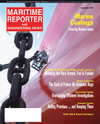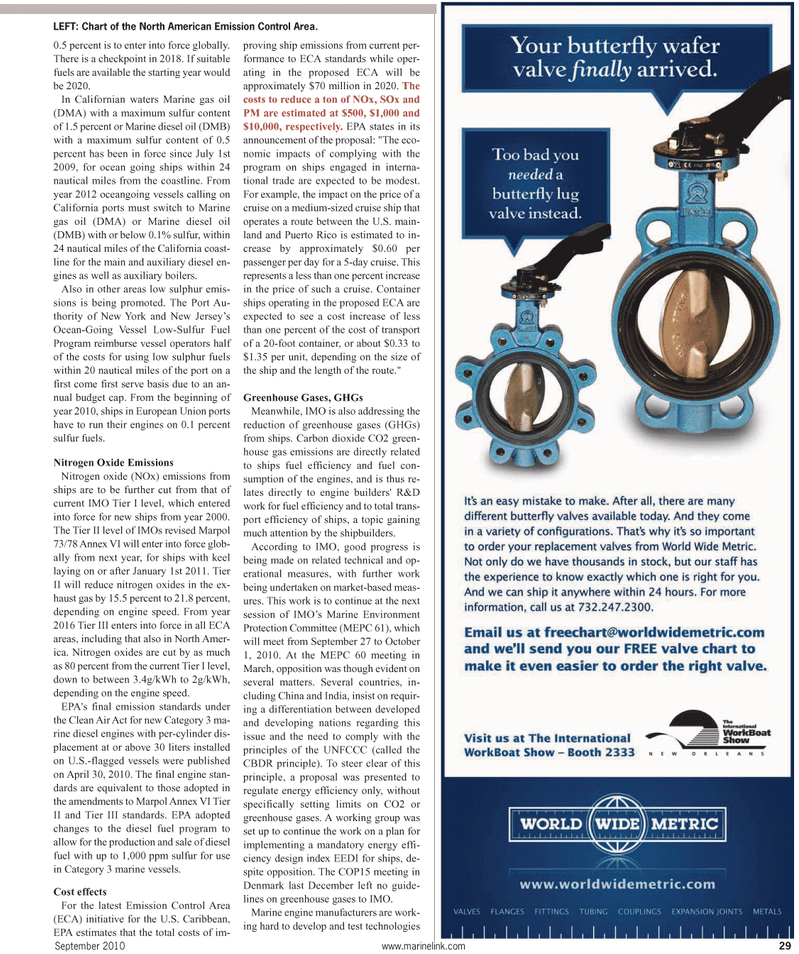
Page 29: of Maritime Reporter Magazine (September 2010)
Marine Propulsion Edition
Read this page in Pdf, Flash or Html5 edition of September 2010 Maritime Reporter Magazine
September 2010 www.marinelink.com 29 0.5 percent is to enter into force globally.
There is a checkpoint in 2018. If suitable fuels are available the starting year would be 2020.
In Californian waters Marine gas oil (DMA) with a maximum sulfur content of 1.5 percent or Marine diesel oil (DMB) with a maximum sulfur content of 0.5 percent has been in force since July 1st 2009, for ocean going ships within 24 nautical miles from the coastline. From year 2012 oceangoing vessels calling on
California ports must switch to Marine gas oil (DMA) or Marine diesel oil (DMB) with or below 0.1% sulfur, within 24 nautical miles of the California coast- line for the main and auxiliary diesel en- gines as well as auxiliary boilers.
Also in other areas low sulphur emis- sions is being promoted. The Port Au- thority of New York and New Jersey’s
Ocean-Going Vessel Low-Sulfur Fuel
Program reimburse vessel operators half of the costs for using low sulphur fuels within 20 nautical miles of the port on a first come first serve basis due to an an- nual budget cap. From the beginning of year 2010, ships in European Union ports have to run their engines on 0.1 percent sulfur fuels.
Nitrogen Oxide Emissions
Nitrogen oxide (NOx) emissions from ships are to be further cut from that of current IMO Tier I level, which entered into force for new ships from year 2000.
The Tier II level of IMOs revised Marpol 73/78 Annex VI will enter into force glob- ally from next year, for ships with keel laying on or after January 1st 2011. Tier
II will reduce nitrogen oxides in the ex- haust gas by 15.5 percent to 21.8 percent, depending on engine speed. From year 2016 Tier III enters into force in all ECA areas, including that also in North Amer- ica. Nitrogen oxides are cut by as much as 80 percent from the current Tier I level, down to between 3.4g/kWh to 2g/kWh, depending on the engine speed.
EPA's final emission standards under the Clean Air Act for new Category 3 ma- rine diesel engines with per-cylinder dis- placement at or above 30 liters installed on U.S.-flagged vessels were published on April 30, 2010. The final engine stan- dards are equivalent to those adopted in the amendments to Marpol Annex VI Tier
II and Tier III standards. EPA adopted changes to the diesel fuel program to allow for the production and sale of diesel fuel with up to 1,000 ppm sulfur for use in Category 3 marine vessels.
Cost effects
For the latest Emission Control Area (ECA) initiative for the U.S. Caribbean,
EPA estimates that the total costs of im- proving ship emissions from current per- formance to ECA standards while oper- ating in the proposed ECA will be approximately $70 million in 2020. The costs to reduce a ton of NOx, SOx and
PM are estimated at $500, $1,000 and $10,000, respectively. EPA states in its announcement of the proposal: "The eco- nomic impacts of complying with the program on ships engaged in interna- tional trade are expected to be modest.
For example, the impact on the price of a cruise on a medium-sized cruise ship that operates a route between the U.S. main- land and Puerto Rico is estimated to in- crease by approximately $0.60 per passenger per day for a 5-day cruise. This represents a less than one percent increase in the price of such a cruise. Container ships operating in the proposed ECA are expected to see a cost increase of less than one percent of the cost of transport of a 20-foot container, or about $0.33 to $1.35 per unit, depending on the size of the ship and the length of the route."
Greenhouse Gases, GHGs
Meanwhile, IMO is also addressing the reduction of greenhouse gases (GHGs) from ships. Carbon dioxide CO2 green- house gas emissions are directly related to ships fuel efficiency and fuel con- sumption of the engines, and is thus re- lates directly to engine builders' R&D work for fuel efficiency and to total trans- port efficiency of ships, a topic gaining much attention by the shipbuilders.
According to IMO, good progress is being made on related technical and op- erational measures, with further work being undertaken on market-based meas- ures. This work is to continue at the next session of IMO’s Marine Environment
Protection Committee (MEPC 61), which will meet from September 27 to October 1, 2010. At the MEPC 60 meeting in
March, opposition was though evident on several matters. Several countries, in- cluding China and India, insist on requir- ing a differentiation between developed and developing nations regarding this issue and the need to comply with the principles of the UNFCCC (called the
CBDR principle). To steer clear of this principle, a proposal was presented to regulate energy efficiency only, without specifically setting limits on CO2 or greenhouse gases. A working group was set up to continue the work on a plan for implementing a mandatory energy effi- ciency design index EEDI for ships, de- spite opposition. The COP15 meeting in
Denmark last December left no guide- lines on greenhouse gases to IMO.
Marine engine manufacturers are work- ing hard to develop and test technologies
LEFT: Chart of the North American Emission Control Area.

 28
28

 30
30
